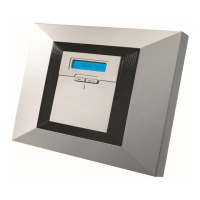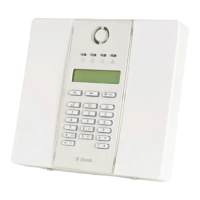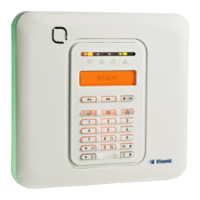DE5467U 23
Sirens do not always wake up sound sleepers: Sirens
and bells installed outside or far from bedrooms are not likely
to awaken people who are sound asleep behind closed doors
inside the protected area or in adjacent buildings.
The system is sometimes defeated: With sufficient
technical know-how, intruders may find a way to defeat
various types of sensor or disconnect warning devices.
Intruders may also take advantage of unprotected
openings and skylights, or even enter forcibly at
unpredictable spots.
Smoke detectors have their limits: In many cases,
smoke detectors fail to warn on time because the fire
started at a different level of the house, or too far away
from the detector.
All this gives sufficient proof that even with a good
alarm system installed, there is still need for life and
property insurance. In addition, users should test their
alarm systems at regular intervals, to make sure that
malfunctions are detected before a true alarm event
occurs.
APPENDIX A. GLOSSARY
This list of terms is arranged in alphabetical order. Any
term indicated by cursive (italic) letters within the
explanatory text can be looked up separately.
Abort Period: When an alarm is initiated, the internal
sounder is activated first for a limited period of time which is
the abort period
set by the installer. If you cause an alarm
accidentally, you can disarm the system within the abort
period before the real sirens start and before the alarm is
reported to the remote responders.
Alarm: There are 2 kinds of alarm:
Loud alarm
- both internal and external sirens blare out
constantly and the control panel reports the event by
telephone.
Silent alarm - the sirens remain silent, but the control panel
reports the event by telephone.
A state of alarm is caused by:
• Motion detected by a motion detector
• Change of state detected by a magnetic contact detector -
a closed window or door is opened
• Detection of smoke by a smoke detector
• Tampering with any one of the detectors
• Pressing the two emergency buttons simultaneously (panic)
Arming: Arming the alarm system is an action that prepares
it to sound an alarm if a zone is “violated” by motion or by
opening a door or window, as the case may be. The control
panel may be armed in various modes (see AWAY, HOME,
INSTANT and LATCHKEY).
AWAY: This type of arming is used when the protected site is
vacated entirely. All zones, interior and perimeter alike, are
protected.
Chime Zones: Allow you to keep track of activity in the
protected area while the alarm system is in the disarmed
state. Whenever a chime zone is "opened", the buzzer beeps
twice. The buzzer doesn't beep, however, upon closing the
zone (return to normal). Residences can use this feature to
annunciate visitors or look after children. Businesses can use
it to signal when customers enter the premises or when
personnel enter restricted areas.
Note: Your installer will never designate a 24-hour zone or a
fire zone as a chime zone, because both zone types actuate
an alarm if disturbed while the system is in the disarmed
state.
Although one zone or more are designated as chime zones,
you can still enable or disable the chime function.
Control Panel: The control panel is a cabinet that
incorporates the electronic circuitry and microprocessor that
control the alarm system. It collects information from various
sensors, processes it and responds in various ways. It also
includes the user-interface - control keys, numerical keypad,
display, sounder and loudspeaker.
Disarming: The opposite of arming - an action that restores
the control panel to the normal standby state. In this state,
only fire and 24-hour zones will sound an alarm if violated,
but a “panic alarm” may also be initiated.
Disturbed Zone: A zone in a state of alarm (this may be
caused by an open window or door or by motion in the field of
view of a motion detector). A disturbed zone is considered
“not secured”.
Forced Arming: When any one of the system zones is
disturbed (open), the alarm system cannot be armed. One
way to solve this problem is to find and eliminate the cause
for zone disturbance (closing doors and windows). Another
way to deal with this is to impose forced arming - automatic
de-activation of zones that are still disturbed upon
termination of the exit delay. Bypassed zones will not be
protected throughout the arming period. Even if restored to
normal (closed), bypassed zones will remain unprotected
until the system is disarmed.
Permission to “force arm” is given or denied by the installer
while programming the system.
HOME: This type of arming is used when people are present
within the protected site. A classic example is night-time at
home, when the family is about to retire to bed. With HOME
arming, perimeter zones are protected but interior zones are
not. Consequently, motion within interior zones will be
ignored by the control panel, but disturbance of a perimeter
zone will cause an alarm.
Instant: You can arm the system AWAY-INSTANT or HOME-
INSTANT, thereby canceling the entry delay for all delay
zones for the duration of one arming period.
For example, you may arm the control panel in the HOME-
INSTANT mode and remain within the protected area. Only
perimeter protection is active, and if you do not expect
somebody to drop in while the system is armed, alarm upon
entry via the main door is an advantage.
To disarm the system without causing an alarm, use your
control keypad (which is normally accessible without
disturbing a perimeter zone) or use a keyfob transmitter.
Latchkey: The Latchkey mode is a special arming mode in
which designated "latchkey users" will trigger a "latchkey
message" to be sent to a telephone or a pager when they
disarm the system.
For example, if a parent wants to be sure that their child has
returned from school and disarmed the system. Latchkey
arming is only possible when the system is armed in the
AWAY mode.
Magnetic Contact Detector, Wireless: A Magnet- controlled
switch and a wireless PowerCode transmitter in a shared
housing. The detector is mounted on doors and windows to
detect changes in state (from closed to open and vice versa).
Upon sensing that a door or window is open, the detector
transmits its unique identification code accompanied by an
“alarm” signal and various other status signals to the control
panel. The control panel, if not armed at that time, will
consider the alarm system as “not ready for arming” until it
receives a “restored” signal from the same detector.

